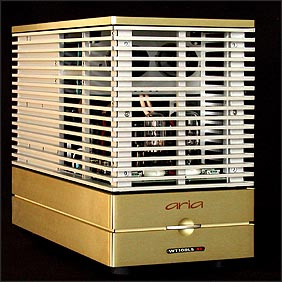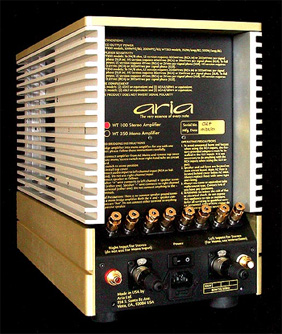You are reading the older HTML site
Positive Feedback ISSUE
4december/january 2003
as reviewed by Mark Katz

MARK KATZ'S SYSTEM LOUDSPEAKERS ELECTRONICS SOURCES CABLES ACCESSORIES
|
I’ve recently had the pleasure of listening to the low-sensitivity, extra-quality Aria WT100 hybrid amplifier. The low-sensitivity version is made for high-output preamps like my tubed Kora Eclipse. "Extra quality" implies better parts than the already very good ones used in the standard version of the amp. Designed by Mike Elliot, previously of the sadly defunct Counterpoint, the WT100 is a 100-watt amp with a tube input stage and a bipolar transistor output stage, shaped somewhat like two shoeboxes stacked on top of one another. It is deep and relatively tall, but narrow, with ventilation around the edges and a solid top. I’ve owned a Counterpoint preamp and have heard some of Mike Elliot’s earlier designs, including the SA-100, SA-220, and later NPS models. I’ve also used a Lazarus tube/Mosfet hybrid amp, so I’m familiar with the concept.
The WT100 is a product of evolution, reflecting the designer’s dream of a hybrid amp getting the best of both tube and solid state character. The back has two sets of closely spaced outputs, so those with bi-wired speakers can rest easy, and two sets of inputs, both XLR and RCA. I used the RCA jacks. Mike also provided two sets of output networks that go across the speaker terminals to help the amp drive speakers with more difficult impedance loads without overheating. I used them, but the amp drove my speakers fine without them. The main switch is located on the back of the amp, with another on/off switch conveniently located in front, so the amp may be in standby mode or completely off. I used a Tiff power cord connected to a dedicated outlet that would otherwise have been plugged into one of my Kora Cosmos monoblock amps.
The manual was very informative, and stressed user’s ability to customize the amplifier. A user who requires a huge amount of power can easily change it into a WT350 monoblock amp (350 watts into 8 ohms). He’d still have to buy another amplifier, but isn’t stuck with "only" 100 watts per channel. With my 4-ohm speakers, the WT-100 provided more like 200 watts per channel, so one amp was more than adequate. Another way to customize the sound is to change the input tubes. I took off the front panel using the supplied hex wrench and "rolled" some of the tubes supplied for the review. First of all, forget about the Sovtek 6SN7s. They’re a starting point and, as noted in the manual, are not necessarily the most musical choice. My favorite of the other supplied tubes were the RCA 5692s. I felt that they gave a combination of good detail and forgiving warmth.
I set up the amp on my big system, which consists of a CEC TL-1 transport connected with a Marigo digital interconnect to a highly modified Kora Hermes DAC, connected to a Kora Eclipse preamp, and then to my Kora Cosmos amps by Goertz triode interconnects. Kimber 8TC shotguns link the amp to the JM Labs Mezzo Utopias. Out went the Kora Cosmos amps, in went the Aria. The amp was plugged directly into the wall. The preamp used the high current outlet of a Power Wedge 116II, the rest of the components used the filtered outlets. I listened on a variety of music including vocal, banjo, piano, pipe organ, orchestral, and violin. My vocal reference was the Dorian recording of Bach’s Coffee Cantata (DOR-90199). I love the cleverness and humor of the piece, as well as the very fine performances and recording quality. For the purpose of this review, the balance of harpsichord, period orchestra, and the vocal ranges were the primary considerations. The tenor, baritone, and soprano were all portrayed very naturally, with good power and projection. The "Acht" of the baritone rang out clearly. The harpsichord was very detailed, but not edgy or excessively clattery. The soprano’s voice was sweet and textured. I heard the breathiness of the solo flute prior to her aria about the joys of caffeine consumption. Soundstage placement was also good, with both width and depth.
The Rutter Requiem (Reference Recordings RR-57) has various instruments, the Turtle Creek Chorale and Dallas Women’s Chorus, and a whomping pipe organ. I used track seven, "Pie Jesu," with Nancy Keith as solo soprano contrasting with the chorus and instruments. Bass control of the lower organ notes was good, given the limitations of my Mezzo Utopias on sub-30Hz signals, but not as good as a larger solid state amp I tried (to be discussed in another review). The massed chorus had power and musicality. I was able to make out ambient cues to the recording venue, helping the much-needed suspension of disbelief of having a chorus and pipe organ in my living room.
Bela Fleck’s classical banjo album, Perpetual Motion, a title in tribute to Paganini (Sony Classical SK 89610), is a testament to versatility. It’s also an unusual set of renditions of familiar works by composers from Scarlatti and Bach to Debussy. Accompanied by special guests like Joshua Bell and John Williams, Fleck gives some unique and skilled performances. I’ve never heard a banjo performing Chopin mazurkas before! The amp kept up well with the banjo and John William’s guitar on track four, giving both the initial plucks and tone. Joshua Bell’s violin, both bowed and plucked, also sounded very convincing—musical, not harsh or glassy. As an aside, I was particularly impressed with the virtuosity of Fleck’s bluegrass version of "Moto Perpetuo."
Naum Starkman’s recording of Chopin’s Polonaise, Opus 40, #1 on Pope Music PM 1010-2 is a powerhouse that borders on the edge of unlistenability at times due to the clattering of the piano. The initial impact of the louder notes sounded a bit more clattery than I’m used to with my Kora amps, which may soften things a bit. Earl Wild Plays His Transcriptions of Gershwin (Chesky CD 32) is a fantastic CD consisting of a "Fantasy on Porgy and Bess," "Improvisations on ‘Someone to Watch Over Me’," and "Seven Virtuoso Etudes" of popular Gershwin tunes. Imagine Gershwin written by a late Romantic Era virtuoso pianist. The quality of both Earl Wild’s playing and the Chesky recording are superb. With the Aria amp, I heard none of the excessive clattery character that distracted me with the Starkman recording. Runs were well defined and the piano well balanced. I could appreciate the complex resonance and dynamics of the piano without losing the sense of effortless speed of the faster sections. I’ve heard amps that make this CD sound a bit sluggish by being excessively warm and syrupy, and others that don’t let the tonal complexity of the piano come through.
I compared this amp to my old Lazarus hybrid as well as to my Kora Cosmos Triode monoblocks. The Lazarus didn’t have quite the energy or sense of ease of the Aria. The Kora amps had a bit more treble sparkle and a subtler midrange, but again didn’t have quite as much energy or bass impact. I feel that the Aria is well balanced and musical. I liked its tonal character and its ability to turn the stereo amp into a much more powerful monoblock. The WT100 XL LS hybrid amp does give much of the best of both worlds. Recommended. Mark Katz

Coming up in Issue 5, read the reviews of the Aria WT100 by Dave and Carol Clark, and Art Shapiro. More to follow!
MANUFACTURER'S RESPONSE
Many thanks to Mark Katz for taking the time to review the Aria WT100LS XL. Bringing these amplifiers to market is a dream come true: I love designing audio equipment, and people familiar with my work with Counterpoint know that the challenge of getting that "tube sound" to my speakers while avoiding the heat, unreliability, and expense of a large tubed output stage has been one of my passions and a trademark of my designs. I'm glad that Mark enjoyed the results.
On a technical note, the amplifier has been updated a bit so there is no longer any need for the output networks Mark mentioned. They were originally intended to compensate for high-capacitance speaker loads, whether due to cables with high-capacitance or speakers that presented an unusually high amount of capacitance. If the "magic value" of 0.02uF was presented to the amplifier, some overshoot and ringing at the speaker terminals could be observed. The network damped the system to prevent ringings. However, we have made a small change to the amplifier's driver stage which totally eliminates the ringing under that rare condition and now the amplifier is perfectly happy with all loads.
Best regards,
Michael Elliott
WT100 XL LS stereo amplifier
Retail $8800
Aria
Audio
TEL: 877. 517. 4247
(toll-free), or 760. 945. 0356
web address: www.ariaaudio.com
email address: [email protected]
